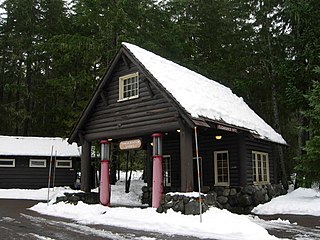
Longmire, which is effectively encompassed by the Longmire Historic District, is a visitor services center in Washington State's Mount Rainier National Park, located 6.5 miles (10.5 km) east of the Nisqually Entrance. The area is in the Nisqually River valley at an elevation of 2,761 feet (842 m) between The Ramparts Ridge and the Tatoosh Range. Longmire is surrounded by old-growth douglas fir, western red cedar and western hemlock.
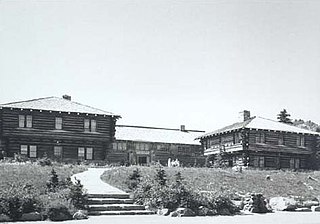
The Yakima Park Stockade Group, also known as North and South Blockhouses, Museum, and Stockade at Sunrise, is a building complex consisting of four log buildings at the Sunrise Visitors Center area in the northeast part of Mount Rainier National Park. The complex is architecturally significant as a particularly fine example of rustic frontier log architecture. The first of the blockhouses and the stockade were built in 1930, while the second blockhouse followed in 1943. It was declared a National Historic Landmark in 1987. It is in turn part of the Mount Rainier National Historic Landmark District, which encompasses the entire park and which recognizes the park's inventory of Park Service-designed rustic architecture.

Munson Valley Historic District is the headquarters and main support area for Crater Lake National Park in southern Oregon. The National Park Service chose Munson Valley for the park headquarters because of its central location within the park. Because of the unique rustic architecture of the Munson Valley buildings and the surrounding park landscape, the area was listed as a historic district on the National Register of Historic Places (NRHP) in 1988. The district has eighteen contributing buildings, including the Crater Lake Superintendent's Residence which is a U.S. National Historic Landmark and separately listed on the NRHP. The district's NRHP listing was decreased in area in 1997.

Camp Muir, named for the naturalist John Muir, is a high-altitude refuge for climbers in Mount Rainier National Park in Washington, accessed through the Paradise Entrance. The shelters comprising the camp are situated at a 10,188 ft (3,105 m) elevation between the Muir Snowfield and the Cowlitz Glacier on Mount Rainier. Camp Muir is the most-used base camp for those attempting to climb to the mountain's summit. Camp Muir is between the Nisqually and Paradise Glaciers.
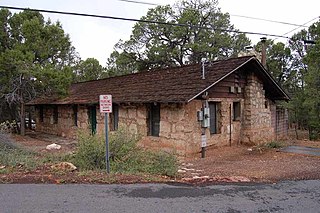
The Ranger's Dormitory at the South Rim of Grand Canyon National Park was built in 1920–21. Originally built as a worker's dormitory, it was converted for use by rangers in 1927. The stone building was designed by Daniel Ray Hull of the National Park Service Branch of Plans and Designs, and is a precursor of the later National Park Service Rustic style.

The Sunrise Comfort Station (S-310) is a comfort station in Mount Rainier National Park, Washington, USA. Built around 1930, the building was designed by Thomas Chalmers Vint of the National Park Service in association with landscape architect E.A. Davidson. The structure was part of a planned ensemble at what was then called Yakima Park, high on the northern flank of Mount Rainier. Similar structures may be found at the Ohanapecosh, Longmire and White River campgrounds in the park. The low building is framed in peeled logs on a stone foundation, set into a hillside and surrounded by native landscaping.
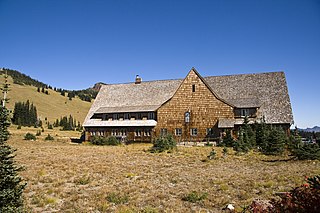
The Sunrise Historic District, also known as the community of Sunrise, Washington, is located at approximately 6,400 feet (2,000 m) on a ridge overlooking the northeast side of Mount Rainier in Mount Rainier National Park. The district comprises seven individual structures designed in accordance with the principles of the National Park Service Rustic style. The area is inhabited and open to the public only during a brief period in the summer season.

The White River Entrance to Mount Rainier National Park is a complex of buildings built between 1929 and 1931 to accommodate visitors arriving on the Yakima Park Highway, in the northeastern portion of the park. Like most of the structures in Mount Rainier, the buildings are designed in the National Park Service Rustic style, using natural stone and log materials. The historic district includes the 1933 Men's Mess Hall and Dormitory, believed to be the only surviving camp structure built by the Civilian Conservation Corps in the park.

The Chinook Pass Entrance Arch marks the east entrance to Mount Rainier National Park. The rectangular log entry arch is one of several placed at the entrances to the park. It was designed in 1933 by the National Park Service Branch of Plans and Designs, and was built in 1936 by the Civilian Conservation Corps. The arch consists of two stone abutments carrying horizontal logs over the road. The arch functions as a bridge, carrying a horse trail, which is now part of the Pacific Crest Trail.

The Wonderland Trail is an approximately 93 mile (150 km) hiking trail that circumnavigates Mount Rainier in Mount Rainier National Park, Washington, United States. The trail goes over many ridges of Mount Rainier for a cumulative 22,000 feet (6,700 m) of elevation gain. The trail was built in 1915.

The Narada Falls Comfort Station was built in Mount Rainier National Park by the National Park Service and the Civilian Conservation Corps in 1941–42. The public toilet building is close to Narada Falls in the south central portion of the park. Initial work by the Park Service encountered substantial rock excavation, with the subsequent cost overrun requiring the Park Service to use CCC labor to complete the project. The building features stone masonry walls to window sill level, woor framed upper walls, and a timber framed roof. The interior comprises a waiting room and a toilet facility. The design was by the Western Region Landscape Engineering Division, with plan approval by Thomas Chalmers Vint, NPS Chief of Planning.

The Gobbler's Knob Fire Lookout is a fire lookout tower in the extreme western region of Mount Rainier National Park at an elevation of 5,485 feet (1,672 m). One of four fire lookouts remaining in the park, the lookout is used for visitor services during summer weekends. The building is about 14 feet (4.3 m) by 14 feet (4.3 m), and was designed by the National Park Service Branch of Plans and designs under the supervision of Acting Chief Architect Edwin A. Nickel. It was built in 1933. The two-story structure features a balconied lookout on the second level, with storage on the ground level. Cables secured to deadmen keep the lookout from blowing over. The lookout was extensively damaged in a 2006 storm. It has since been repaired.

The White River Bridge was built in 1929 in Mount Rainier National Park as part of the Yakima Park Road project. The new road was planned to open up access to the northeastern portion of the park. The bridge, spanning the White River, was built by contractor John D. Tobin of Portland, Oregon, who had previously built the Narada Falls Bridge and the Christine Falls Bridges, both listed on the National Register of Historic Places. Plans for the bridge were drawn by the National Park Service Branch of Plans and Designs in the National Park Service Rustic style, with construction supervision by NPS landscape architect Ernest A. Davidson. The three-centered arch spans 60 feet (18 m), with a stone-faced concrete structure.
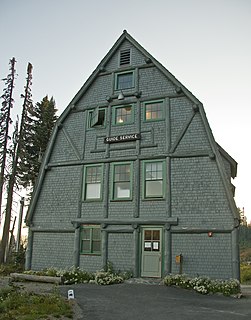
The Paradise Historic District comprises the historic portion of Paradise developed area of Mount Rainier National Park. The subalpine district surrounds its primary structure, the Paradise Inn, a rustic-style hotel built in 1917 to accommodate visitors to the park. The Paradise Inn is a National Historic Landmark. Five other buildings are included in the district. The district was placed on the National Register of Historic Places on March 13, 1991. It is part of the Mount Rainier National Historic Landmark District, which encompasses the entire park and which recognizes the park's inventory of Park Service-designed rustic architecture.

The St. Andrews Patrol Cabin was built by the National Park Service in 1922 as part of a network of stations near the boundaries of Mount Rainier National Park for rangers on patrol. The one-room log structure stands on the Wonderland Trail that circumnavigates Mount Rainier. The exterior of the cabin features a porch to the front. The interior is finished with varnished logs and tongue and groove flooring. The cabin was placed on the National Register of Historic Places on March 13, 1991. It is part of the Mount Rainier National Historic Landmark District, which encompasses the entire park and which recognizes the park's inventory of Park Service-designed rustic architecture.

The Mount Fremont Fire Lookout is a fire lookout in the northern region of Mount Rainier National Park at an elevation above 7,000 feet (2,100 m), the highest in the park. One of four fire lookouts remaining in the park, the lookout is used for visitor services during summer weekends. The building is about 14 by 14 feet, and was designed by the National Park Service Branch of Plans and designs under the supervision of Acting Chief Architect Edwin A. Nickel. It was built in 1933. The two-story structure features a balconied lookout on the second level, with storage on the ground level. Cables secured to deadmen keep the lookout from blowing over. The Park Service was assisted during construction by the Emergency Conservation Works Association.

The Nisqually Entrance Historic District comprises the first public entrance to Mount Rainier National Park. The district incorporates the log entrance arch typical of all Mount Rainier entrances, a log frame ranger station and checking station, a comfort station and miscellaneous service structures, all built around 1926, as well as the 1915 Superintendent's Residence and the 1908 Oscar Brown Cabin, the oldest remaining structure in the park. The buildings in the district conform to the principles of the National Park Service Rustic style that prevailed in park design of the 1920s and 1930s.

The St. Andrews Creek Bridge was built in 1930-31 as part of the West Side Road in Mount Rainier National Park.

The South Puyallup River Bridge was built in 1930–31 in Mount Rainier National Park as part of the West Side Road project, planned to link the park's Nisqually and Carbon River entrances. The stone-faced reinforced concrete bridge was designed by the National Park Service and the Bureau of Public Roads. It spans 42 feet (13 m) and is almost 35 feet (11 m) wide, carrying two lanes of traffic.
Architects of the National Park Service are the architects and landscape architects who were employed by the National Park Service (NPS) starting in 1918 to design buildings, structures, roads, trails and other features in the United States National Parks. Many of their works are listed on the National Register of Historic Places, and a number have also been designated as National Historic Landmarks.



















